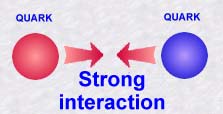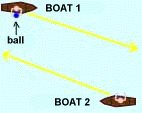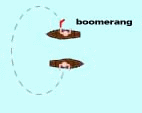The four fundamental interactions
or
a boson, how does it work?
or
a boson, how does it work?
![]() About
the importance of movement
About
the importance of movement
 We have
seen the world of material particles.
We have
seen the world of material particles.
This world is only one of the two facets of the Universe around us.
In effect, all of the physical, chemical and biological phenomena such
as the fall of an apple from a tree, the light emitted from an electric
lamp, a good soufflé which inflates in the oven or even the beating
of your heart; all of these phenomena could not exist if it wasn't for
the fact that movement is possible. This appears obvious but all
the same, of all things, how is movement possible? There is always at the
origin of movement, an impulse, a force which is the cause... Now
physicists, in their search for a unified vision of the world, have succeeded
in reducing to exactly four (or maybe even less, we will see at the end
of this chapter) the number of forces loose in the vast Universe.
These forces are:

![]()
![]() These
forces are called interactions. Why?
These
forces are called interactions. Why?
Before quantum theory, forces were transmitted by virtue of a mysterious
force
field emitted by particles.
According to quantum theory, forces are not exherted between two fermions
unless there is an exchange of a mediator particle, called a boson.
Now the heavier the boson, the shorter will be the range of the interaction.
This theory bears the indigestible name of quantum electrodynamics.
![]()
![]() How
to represent this curious concept?
How
to represent this curious concept?
Replace two fermions with two small boats, each with a quiet fisherman aboard. Imagine then that the two fishermen drift on a lake and come inexorably closer to each other... Now these absent minded fishermen have neither oars nor a motor to deviate their trajectories. What to do? By chance, one of the fishermen has in his boat a boson, excuse me a big bowling ball (and why not? he is very absent minded).
 As
the two boats approach, the amateur bowling fisherman has a flash of genius
and forcefully throws the heavy ball towards his colleague.
As
the two boats approach, the amateur bowling fisherman has a flash of genius
and forcefully throws the heavy ball towards his colleague.
What will happen?
He and his boat will be deviated by the reaction, by as much as the
fisherman has pushed against the ball during the throw. The ball departs
in one direction and the fisherman-boat ensemble departs in the opposite
direction (of course more gently because the boat and its occupant are
much heavier to move).
The scenario is the inverse for fisherman N°2 who receives the ball:
The kinetic energy of the ball will, at the moment when fisherman 2 catches
it, divert boat 2 under the force of the impact.
Final result: The two boats will be deviated and distance themselves
from each other...
 Sure,
this analogy has its limits because it only works for repulsive forces,
unless we replace the bowling ball by a heavy boomerang which could emulate
attractive forces...
Sure,
this analogy has its limits because it only works for repulsive forces,
unless we replace the bowling ball by a heavy boomerang which could emulate
attractive forces...
Anyway, it's clear that the heavier the ball, the greater the force
of repulsion, but also that the force is greater the shorter the distance
between the boats, because to throw a bowling ball a long way requires
lots of energy!
Next you see each of these interactions in order of notoriety: